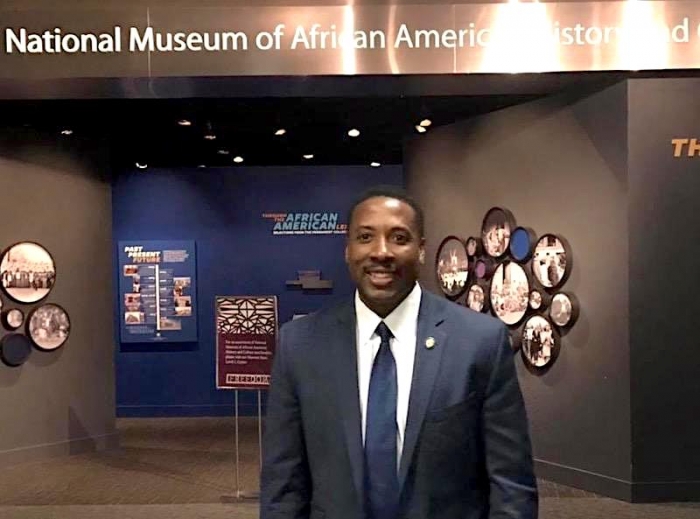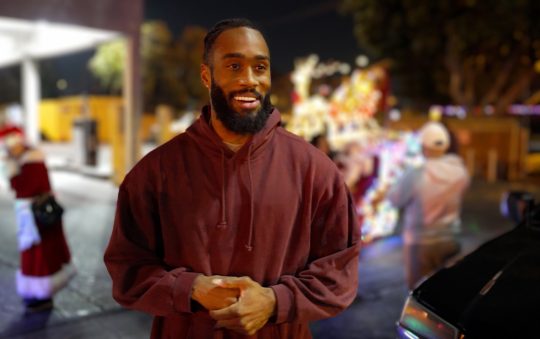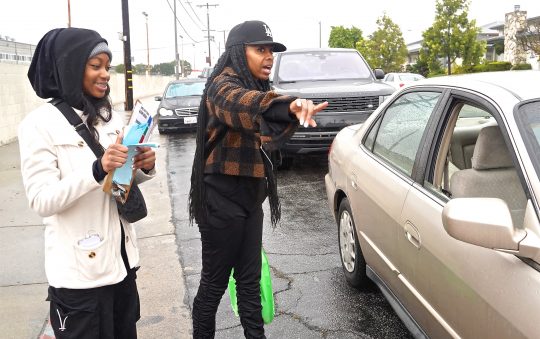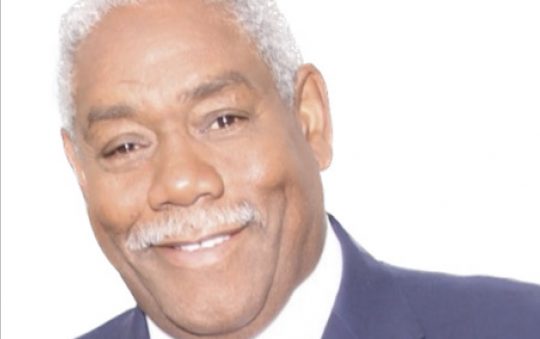The Sentinel goes one-on-one with Sergeant Andre Clansy, Los Angeles Police Department Gang Intervention Liaison
Many may know about the Gang Reduction Youth Development Office (GRYD), established by the Los Angeles Mayor’s Office in 2007, to establish an office to coordinate comprehensive efforts to reduce gang violence, target specific areas that had the most gang violence, combine all the City’s programs within the Mayor’s Office, and to develop strong partnerships with City departments and community civic groups.
But what has been the role of the Los Angeles Police Department (LAPD) with GRYD – both as it relates to gang policing and interactions with men and women, the gang intervention specialists who have been serving their communities on the front lines of street wars decades before the program’s existence?
In this one-on-one interview with Sentinel contributing writer Charlene Muhammad, Sergeant Andre Clansy, LAPD Gang Intervention Liaison, sheds light on how it partners with community gang interventionists to keep neighborhoods safe.
LOS ANGELES SENTINEL (LAS): Break down the two components of GRYD, out of the Mayor’s Office and LAPD.
SERGEANT ANDRE CLANSY (AC): The police department has a liaison with GRYD. We don’t have a GRYD Office. So, GRYD is like a wrap-around service as far as they bring a bunch of entities together. They have a strategic, comprehensive strategy on how to service the community, as far as prevention and intervention. What LAPD has, we’re a law enforcement agency, we’ve got several people, not only me. I’m just a person that represents the Chief of Police. All our entities across our geographical division has somebody who has a relationship with a GRYD component and a GRYD counterpart. So every division or every area within LAPD has several service providers, of course, and they operate under a GRYD contract and our officers, maybe they Gang Impact Team lieutenants, will have monthly meetings with tase service providers so we could share information back and forth for what’s going on, what’s happening, and what we, as LAPD, could do better to support the GRYD function.
For me, I go around this whole city, just making sure that things are getting done as far as they have to for LAPD. Sometimes, we get a situation where we have decisions to make as far as how much information do we share, or issues going between the CIWs (Community Intervention Workers) from the streets, and our gang enforcement officers to make sure we understand each other’s jobs and responsibilities.
How I do that, I also operate a gang intervention awareness program within LAPD to educate our LAPD officers on the service that Community Intervention Workers do on the streets, so they could be fully aware, because some of our coppers do not understand the function of GRYD, what the GRYD is supposed to do. Our class, we operate every month for LAPD officers to introduce them to what the GRYD strategy is and what the duties and responsibilities are of Community Intervention Workers.
LAS: How many have been turned out?
AC: It’s been operating for the last seven years. I just came on board a year ago, and so far, we’ve trained over 1,000 officers, and particularly at the beginning of the year, we trained all of Metropolitan Division. And right now, we are re-training the gang officers within LAPD, because as you know, those officers get cycled out every five years, so we want to make sure the new officers who come on board receive this valuable training.
LAS: When did you become involved with GRYD?
AC: My involvement with GRYD goes back a couple of years, but I actually became involved about a year ago, working with Chief (Charlie) Beck, several years ago, and his involvement with the various Community Intervention Workers, his involvement with Cease Fire, his involvement with 2nd Call, and I was there. That garnered my interest in working closely with my community, and particularly GRYD and non-GRYD organizations that goes out in our areas, goes out in our communities, and try to win back our sons and daughters who have one foot in a gang and one foot out.
LAS: Let’s talk about the evolution of GRYD. I remember under Mayor Antonio Villaraigosa, when the GRYD Office was implemented, and there were mixed reactions in the community amongst gang interventionists, as well as community activists and residents. Do you have any insight into any evolution in terms of those relationships?
AC: I can talk on Chief (Michel) Moore’s administration, how he encouraged LAPD to get more involved with the GRYD Program and more involved with the service providers within the community itself, you know, like participating in meetings, opening up our stations to become more transparent. And, I remember Chief (Charlie) Beck going to Cease Fire, and attending the meetings there, and sharing with the community itself certain topics that before were never mentioned to anybody outside of LAPD or outside law enforcement. I mean, open discussions about recent shootings, open discussions about homicides and crime within our neighborhood, and trying to get the community more involved and us sharing more information with them.
LAS: What impact have you seen by GRYD on the streets with people and community policing, along the lines of communication, etc?
AC: I have 24 years on the job and from my earlier days on this police department, where we didn’t share anything or we don’t, we just stayed in our own silo, just LAPD. Now, we’re more open. We’re more transparent. Now, does that circulate through everybody’s department or does everybody in our department believe in this strategy of what the Mayor is trying to achieve? Maybe not, you know. But it’s our job to make sure they understand it, and it’s our job to make sure as they go along, and where our department’s headed, that their behaviors get adjusted.
Now, what I’ve seen on the streets, I’ve seen a lot of improvement. I see a lot of community policing where policing is more empathetic. They’re more sympathetic to what’s going on in our community. They’re more understanding. Take for instance, you’ve got a homicide. And you’ve got the yellow tape up. And you’ve got a young man who was just murdered in the streets. And before, in the 90s, we’d protect that crime scene at all cost. Nobody crosses that yellow tape, and we don’t provide information. You know, we were kind of taught, don’t talk about stuff, because you’re not a detective. We don’t want to let the case go sideways.
So, we have these officers that would stand in line, on that yellow tape, and you have distraught communities, parents, lie ‘That’s my baby! That’s my family member! Tell us something. Can we go over there,” and you got this one stoic officer, like, ‘No! Stay over there! No! Don’t come near the tape! No! I will arrest you!’”
I’ve been through that, too. Now, with the help of GRYD, with the help of our Community Intervention Workers, men who are on that side of the yellow tape, talking for communities. And we are more open now to, ‘Okay. That’s her kid. That’s her son. Bring her over here. Let us share what we know with the parent. Let us be more respectful of the deceased on the ground. Let us be more open to the community and let the community know what’s going on and what’s the next steps. And the CIW workers are awesome, because they’re there to squash rumors, do rumor control. They’re there to assist the families. They’re there to help us to make sure the information we have gets disseminated to the community. That’s how we’re working more and more.
LAPD: has really wrapped their arms around this, I’d say in about the last eight years, wrapped their arms around this … and said hey, we need to do better. We need to be more empathetic. We need to include GRYD, the CIW work on the streets, in what we are doing so the CIWs could be the face of the community, so they could go out into the community and disseminate what we’re trying to do.
LAS: I’ve seen it play out, for instance, what happened with the Gang Database. What have been any challenges with trying to carry out what you’re trying to do with LAPD?
AC: It’s several challenges, but the challenges are more personal or more umm, I’m trying to think of a word … officers’ characteristics. We don’t teach character to our coppers. Coppers inherit character. They get their character from their parents, from their neighbors and through their growing up. What we do as far as character at LAPD, we bring out that character. Sometimes, that character could get exposed, and sometimes that character is not the way we want. If you notice in our history, LAPD history, some of our officers on our jobs show some characters that is not aligned with what our values are. So, what I see, from my experience, we get a few on both sides from my Community Intervention Workers, where they have been traumatized by police officers or they just don’t like police, so therefore, they’re apprehensive about having this professional relationship. On the other side, you’ve got a police officer who just can’t get over a fact that a CIW used to be a gang member, but now he’s transformed his life. That officer still sees that gang member, and our job, my job is to get that officer to see the objective and goal of that “gang member,” is all of our objectives and goals, which is to save lives; and not see the former him, not see the person that was him, and get past the tattoos, get past the stigma of ‘somebody who did prison will never change, will never transform.’
That’s what I’m up against, and that’s not throughout the whole ranks and file of the LAPD. That’s not throughout the whole ranks and file of our GRYD program, but you’ve got the few. You’ve got the few on both sides of the fence that just can’t get over history or whatever you want to call it of what traumatized them.
LAS: That a person has changed?
AC: Exactly. A person has changed. “He never changed. She never changed.” That’s from a copper’s perspective. Then, I have to look at the other’s perspective. When they look at a cop, they look at a uniform, and that uniform may have traumatized them 10, 15 years ago, and they don’t see the man or woman behind the uniform. They just see that uniform, therefore, they throw up their guards and their defense mechanisms and say, ‘I don’t want to do nothing with that person, because that person in that uniform is corrupt, or crooked, or don’t care about me.’
I’ve got work on both sides of the fence. That’s why they see me in a suit more than they see me in a uniform, because when I come as person, I want them to see the man first, not the uniform. So, if they see me approach and they’re talking to me, and are like ‘What you?” and I say I’m LAPD, it’s too late. They already have seen a man! (Chuckles). It’s too late! They’re already wrapped up. We’re shaking hands. We’re laughing and we’re talking about everything. It’s too late. You can’t hate me, now. You can kind of hold back a little bit, but you’ve already seen a man, and he’s a man that cares about you.
LAS: Address the amount of decades-long work, experience and expertise that gang interventionists provide.
AC: Chief Moore made mention of that. We have our crime stats, and even though we had an uptick in some Category 1 crimes, which is violent crime, we have a downtick on some homicides. It’s not because of LAPD 100%. It’s not because we’re out there. It’s because of GRYD. The GRYD program has a significant role in less crime. There is a significant role the play in preventing crime from happening, and Chief Moore recognized that. That’s a great thing, and once the head of the department gets on the news in front of everybody and says it’s because of our brothers and sisters in GRYD that allows people’s lives to be saved, the rank and file of LAPD listens and says okay. That’s what they’re doing. There’s something behind this. And since we have a leader like Chief Moore, I think with his attitude, his direction, his purpose with GRYD, man, I think our future looks brighter than our past days.
LAS: Would you like to add anything?
AC: I thank you for the work you’re doing. I really appreciate it. I thank you for sharing this. I thank the Sentinel for representing my community as an African American and getting the word out. I know the LAPD is not always in a positive light, but on this topic here, we are going in the right direction.
LAS: Thank you very much.








